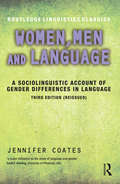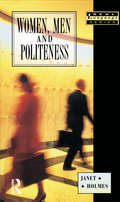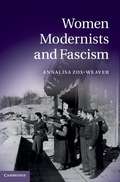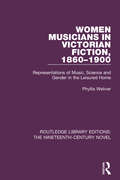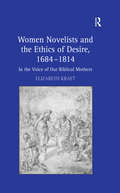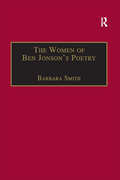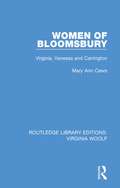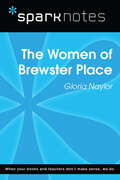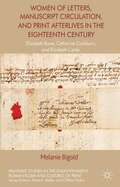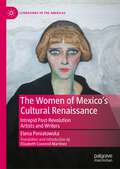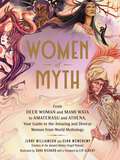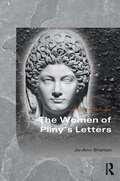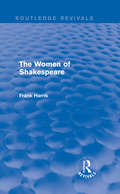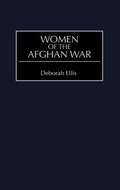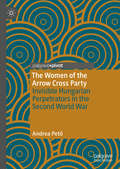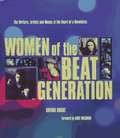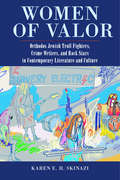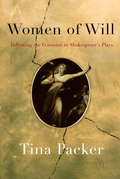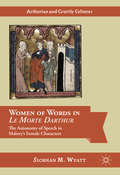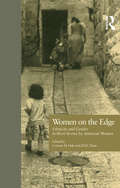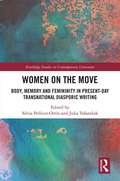- Table View
- List View
Women, Men and Language: A Sociolinguistic Account of Gender Differences in Language (Routledge Linguistics Classics)
by Jennifer CoatesWomen, Men and Language has long been established as a seminal text in the field of language and gender, providing?an account of the many ways in which language and gender intersect. In this pioneering book, bestselling author Jennifer Coates explores linguistic gender differences, introducing the reader to a wide range of sociolinguistic research in the field. Written in a clear and accessible manner, this book introduces the idea of gender as a social construct, and covers key?topics such as conversational practice, same sex talk, conversational dominance, and children’s acquisition of gender-differentiated language, discussing the social and linguistic consequences of these patterns of talk. Here reissued as a Routledge Linguistics Classic, this book contains a brand new preface which situates this text in the modern day study of language and gender, covering the postmodern shift in the understanding of gender and language, and assessing the book’s impact on the field. Women, Men and Language continues to be essential reading for any student or researcher working in the area of language and gender.
Women, Men and Politeness (Real Language Series)
by Janet HolmesWomen, Men and Politeness focuses on the specific issue of the ways in which women and men express politeness verbally.Using a range of evidence and a corpus of data collected largely from New Zealand, Janet Holmes examines the distribution and functions of a range of specific verbal politeness strategies in women's and men's speech and discusses the possible reasons for gender differences in this area. Data provided on interactional strategies, 'hedges and boosters', compliments and apologies, demonstrates ways in which women's politeness patterns differ from men's, with the implications of these different patterns explored, for women in particular, in the areas of education and professional careers.
Women Modernists and Fascism
by Annalisa Zox-WeaverModernism both influenced and was fascinated by the rhetorical and aesthetic manifestations of fascism. In examining how four artists and writers represented fascist leaders, Annalisa Zox-Weaver aims to achieve a more complex understanding of the modernist political imagination. She examines how photographer Lee Miller, filmmaker Leni Riefenstahl, writer Gertrude Stein and journalist Janet Flanner interpret, dramatize and exploit Hitler, Göring and Pétain. Within their own artistic medium, each of these modernists explore confrontations between private and public identity, and historical narrative and the construction of myth. This study makes use of extensive archival material, such as letters, photographs, journals, unpublished manuscripts and ephemera and includes ten illustrations. This interdisciplinary perspective opens up wider discussions of the relationship between artists and dictators, modernism and fascism, and authority and representation.
Women, Murder, and Equity in Early Modern England (Routledge Studies in Renaissance Literature and Culture)
by Randall MartinThis book presents the first comprehensive study of over 120 printed news reports of murders and infanticides committed by early modern women. It offers an interdisciplinary analysis of female homicide in post-Reformation news formats ranging from ballads to newspapers. Individual cases are illuminated in relation to changing legal, religious, and political contexts, as well as the dynamic growth of commercial crime-news and readership.
Women Musicians in Victorian Fiction, 1860-1900: Representations of Music, Science and Gender in the Leisured Home (Routledge Library Editions: The Nineteenth-Century Novel #41)
by Phyllis WeliverOver the first half of the nineteenth century, writers like Austen and Brontë confined their critiques to satirical portrayals of women musicians. Later, however, a marked shift occurred with the introduction of musical female characters where were positively to be feared. First published in 2000, this book examines the reasons for this shift in representations of female musicians in Victorian fiction from 1860-1900. Focusing on changing gender roles, musical practices and the framing of both of these scientific discourses, the book explores how fictional notions of female musicians diverged from actual trends in music making. This book will be of interest to those studying nineteenth century literature and music.
Women Novelists and the Ethics of Desire, 1684–1814: In the Voice of Our Biblical Mothers
by Elizabeth KraftIn Women Novelists and the Ethics of Desire, 1684-1814, Elizabeth Kraft radically alters our conventional views of early women novelists by taking seriously their representations of female desire. To this end, she reads the fiction of Aphra Behn, Delarivier Manley, Eliza Haywood, Sarah Fielding, Charlotte Smith, Frances Burney, and Elizabeth Inchbald in light of ethical paradigms drawn from biblical texts about women and desire. Like their paradigmatic foremothers, these early women novelists create female characters who demonstrate subjectivity and responsibility for the other even as they grapple with the exigencies imposed on them by circumstance and convention. Kraft's study, informed by ethical theorists such as Emmanuel Levinas and Luce Irigaray, is remarkable in its juxtaposition of narratives from ancient and early modern times. These pairings enable Kraft to demonstrate not only the centrality of female desire in eighteenth-century culture and literature but its ethical importance as well.
Women Novelists Before Jane Austen
by Brian CormanBy the time Ian Watt published The Rise of the Novel. in 1957, it was clear that many women novelists before Jane Austen had been overlooked in critical studies of literature and that some of them had been completely forgotten by the reading public. In this book, Brian Corman explores the question of how and why this came about. Corman provides a systematic survey of the reputations of early women novelists as canons of the novel developed over a period of roughly two hundred years, and, in so doing, suggests reasons for their frequent exclusion.Women Novelists before Jane Austen challenges the view that exclusion from the canon was a simple function of gender and goes deeper to examine potential reasons why certain women writers were overlooked. In the process, it provides an overview of histories of the British novel from the beginning through to the mid-twentieth century, ending with the publication of Watt's famous text. Further, Corman offers a prolegomenon to the important recovery work of the late-twentieth century in which many revised accounts of the history of the novel appeared, essentially improving the scope covered by Watt. This study historicizes the place of early women novelists in the British canon in order to provide an informed context for current views.
The Women of Ben Jonson's Poetry: Female Representations in the Non-Dramatic Verse
by Barbara SmithBen Jonson (1572-1637) is recognised as one of the major poets and dramatists of his time. It is surprising, therefore, that this should be the first study to look specifically at the role of women in his poetry. Barbara Smith challenges previously held conceptions of Jonson as a misogynist, upholding the patronage system that allowed him to work. Through detailed examination of his poetic structures, the influence of Juvenal, Martial and Horace, and Jonson's attitudes to his own female patrons, the Countess of Bedford and Lady Mary Wroth, The Women of Ben Jonson's Poetry demonstrates how seventeenth century cultural values and ideas of gender are both supported and subverted in the poems. ’If we "survey Jonson in his works and know him there", we will find the independence of spirit and originality that made him a rarity in his time and ours.'
Women of Bloomsbury: Virginia, Vanessa and Carrington (Routledge Library Editions: Virginia Woolf #2)
by Mary Ann CawsOriginally published in 1990, Women of Bloomsbury takes a fresh look at the lives of Virginia Woolf, her sister Vanessa Bell, and Dora Carrington. Connected by more than bonds of friendship and artistic endeavour, the three women faced similar struggles. Juxtaposing their personal lives and their work, Mary Ann Caws shows us with feeling and clarity the pain women suffer in being artists and in finding – or creating – their sense of self. Relying on unpublished letters and diaries, as well as familiar texts, Caws give us a portrait of the female self in the act of creation.
The Women of Brewster Place (SparkNotes Literature Guide Series)
by SparkNotesThe Women of Brewster Place (SparkNotes Literature Guide) by Gloria Naylor Making the reading experience fun! Created by Harvard students for students everywhere, SparkNotes is a new breed of study guide: smarter, better, faster. Geared to what today's students need to know, SparkNotes provides: *Chapter-by-chapter analysis *Explanations of key themes, motifs, and symbols *A review quiz and essay topicsLively and accessible, these guides are perfect for late-night studying and writing papers
Women of Letters, Manuscript Circulation, and Print Afterlives in the Eighteenth Century
by Melanie BigoldUsing unpublished manuscript writings, this book reinterprets material, social, literary, philosophical and religious contexts of women's letter-writing in the long 18th century. It shows how letter-writing functions as a form of literary manuscript exchange and argues for manuscript circulation as a method of engaging with the republic of letters.
The Women of Mexico's Cultural Renaissance: Intrepid Post-Revolution Artists and Writers (Literatures of the Americas)
by Elizabeth Coonrod Martínez Elena PoniatowskaThis book consists of a collection of essays by Mexican writer Elena Poniatowska in their first English translation, and a critical introduction. The highly engaging essays explore the lives of seven transformational figures for Mexican feminism. This includes Frida Kahlo, Maria Izquierdo, and Nahui Olin, three outstanding artists of the cultural renaissance of the early twentieth century, and Nellie Campobello, Elena Garro, Rosario Castellanos, and Pita Amor, forerunner writers and poets whose works laid a path for Mexican women writers in the later twentieth century. Poniatowska’s essays discuss their fervent activity, interactions with other prominent figures, details and intricacies about their specific works, their scandalous and irreverent activities to draw attention to their craft, and specific revelations about their lives. The extensive critical introduction surveys the early feminist movement and Mexican cultural history, explores how Mexico became a more closed society by the mid-twentieth century, and suggests further reading and films. This book will be of interest both to the general reader and to scholars interested in feminist/gender studies, Mexican literary and cultural studies, Latin American women writers, the cultural renaissance, translation, and film studies.
Women of Myth: From Deer Woman and Mami Wata to Amaterasu and Athena, Your Guide to the Amazing and Diverse Women from World Mythology
by Jenny Williamson Genn McMenemyUncover the fascinating and complex women from mythology and folklore with this collection of stories profiling powerful goddesses, mighty queens, and legendary creatures.Get inspired with 50 fascinating stories of powerful female figures from mythologies around the world. From heroines and deities to leaders and mythical creatures, this collection explores figures of myth who can inspire modern readers with their ability to shape our culture with the stories of their power, wisdom, compassion, and cunning. Featured characters include: -Atalanta: Greek heroine and huntress who killed the Caledonia Boar and joined the Argonauts -Sky-Woman: The first woman in Iroquois myth who fell through a hole in the sky and into our world -Pele: Hawaiian volcano goddess -Clídna: Queen of the Banshees in Irish legend -La Llorona: A ghostly woman in Mexican folklore who wanders the waterfront Celebrate these game-changing, attention-worthy female characters with this collection of engaging tales.
The Women of Pliny's Letters (Women of the Ancient World)
by Jo-Ann SheltonPliny's letters offer a significant source of information about the lives of Roman women (predominantly, though not exclusively, upper-class women) during the late first and early second centuries CE. In the 368 letters included in his ten published books of epistles, Pliny mentions over 30 women by name, addresses letters to seven, and refers to well over 40 anonymous women. Many of the references are brief comments in letters whose topics are the activities of Pliny's male acquaintances. Nonetheless his letters inform us about the roles of women in Roman families, marriages, and households, and also record the involvement of women in such matters as court cases, property ownership, religious orders, social networks, and political activities. This book has two aims. The first is to bring these women to the foreground, to explore their kinships, relationships, and activities, and to illuminate their lives by viewing them in the social, cultural, and political environments of the period in which they lived. This book utilizes historical, literary, legal, and epigraphical sources to examine the events, circumstances, and attitudes that were the contexts for the lives of these women. The first aim, then, is to gain insight into the reality of their lives. The second aim of this book is to investigate how Pliny defines the ideal behavior for women. In his accounts of the actions of both women and men, Pliny frequently shapes his narratives to promote moral lessons. In several of his letters about women, he elevates his subject to the status of a role model. The second aim of this book is to use the descriptions provided by Pliny to acquire a better understanding of what behavior was admired in Roman women of this period, and to consider how the concept of the model Roman woman is constructed in Pliny.
The Women of Shakespeare (Routledge Revivals)
by Frank HarrisFrank Harris argues that the way women are presented in Shakespeare’s plays and sonnets are a reflection of the real-life women in his life, namely his wife, mother, mistress and daughter. Originally published in 1911, The Women of Shakespeare also analyses the traditional criticism of the time and places his own views in this context. This title will be of interest to students of English Literature.
Women of the Afghan War
by Deborah EllisThis is a book about women of Afghanistan and how they cope with war.
The Women of the Arrow Cross Party: Invisible Hungarian Perpetrators in the Second World War
by Andrea PetőThis book analyses the actions, background, connections and the eventual trials of Hungarian female perpetrators in the Second World War through the concept of invisibility. It examines why and how far-right women in general and among them several Second World War perpetrators were made invisible by their fellow Arrow Cross Party members in the 1930s and during the war (1939-1945), and later by the Hungarian people’s tribunals responsible for the purge of those guilty of war crimes (1945-1949). It argues that because of their ‘invisibilization’ the legacy of these women could remain alive throughout the years of state socialism and that, furthermore, this legacy has actively contributed to the recent insurgence of far-right politics in Hungary. This book therefore analyses how the invisibility of Second World War perpetrators is connected to twenty-first century memory politics and the present-day resurgence of far-right movements.
Women of the Beat Generation: The Writers, Artists and Muses at the Heart of a Revolution
by Brenda A. KnightA well-researched book brings to light the fact that the Beat Generation involved women too. This book narrates the sad stories of women married to Beat Poets.
Women of the Left Bank: Paris, 1900-1940
by Shari BenstockA “valuable and intriguing” study of the lives and works of literary women who shaped expatriate Paris (NPR).Focusing on some two dozen American, English, and French women whose talent shaped the Paris expatriate experience in the early twentieth century, from Anais Nin to Alice B. Toklas and beyond, this book shines new light on how gender was experienced and expressed during an important moment in modern literary history."Shari Benstock . . . weaves together, with great skill, the histories of an extraordinary group of talented women—publishers like Sylvia Beach, Caresse Crosby, Margaret Anderson, and Jane Heap, novelists Jean Rhys, Gertrude Stein, and Edith Wharton. She examines in some depth the writing produced by poets, journalists and novelists, thus combining literary criticism and social history in a seamless running narrative.” —NPR“Through their writings, including unpublished and newly available documentary sources of the period, Djuna Barnes, Nancy Cunard, Jean Rhys, Gertrude Stein, Edith Wharton and others are revealed as significant in the development of modernism, imagism and other avant-garde movements in which they were overshadowed or ignored by their male counterparts. . . . Benstock tracks the sexually liberated lifestyles and the creative originality of these women with a wealth of documentation.” —Publishers Weekly“An inspiration, setting a standard for literary history and feminist criticism that will be difficult to surpass.” —American Literature
Women of Valor: Orthodox Jewish Troll Fighters, Crime Writers, and Rock Stars in Contemporary Literature and Culture
by Karen E. SkinaziMedia portrayals of Orthodox Jewish women frequently depict powerless, silent individuals who are at best naive to live an Orthodox lifestyle, and who are at worst, coerced into it. Karen E. H. Skinazi delves beyond this stereotype in Women of Valor to identify a powerful tradition of feminist literary portrayals of Orthodox women, often created by Orthodox women themselves. She examines Orthodox women as they appear in memoirs, comics, novels, and movies, and speaks with the authors, filmmakers, and musicians who create these representations. Throughout the work, Skinazi threads lines from the poem “Eshes Chayil,” the Biblical description of an Orthodox “Woman of Valor.” This proverb unites Orthodoxy and feminism in a complex relationship, where Orthodox women continuously question, challenge, and negotiate Orthodox and feminist values. Ultimately, these women create paths that unite their work, passions, and families under the framework of an “Eshes Chayil,” a woman who situates religious conviction within her own power.
Women of Will
by Tina PackerFrom one of the country's foremost experts on Shakespeare and theatre arts, actor, director, and master teacher Tina Packer offers an exploration--fierce, funny, fearless--of the women of Shakespeare's plays. A profound, and profoundly illuminating, book that gives us the playwright's changing understanding of the feminine and reveals some of his deepest insights. Packer, with expert grasp and perception, constructs a radically different understanding of power, sexuality, and redemption. Beginning with the early comedies (The Taming of the Shrew, Two Gentlemen of Verona, The Comedy of Errors), Packer shows that Shakespeare wrote the women of these plays as shrews to be tamed or as sweet little things with no definable independent thought, virgins on the pedestal. The women of the histories (the three parts of Henry VI; Richard III) are, Packer shows, much more interesting, beginning with Joan of Arc, possibly the first woman character Shakespeare ever created. In her opening scene, she's wonderfully alive--a virgin, true, sent from heaven, a country girl going to lead men bravely into battle, the kind of girl Shakespeare could have known and loved in Stratford. Her independent resolution collapses within a few scenes, as Shakespeare himself suddenly turns against her, and she yields to the common caricature of his culture and becomes Joan the Enemy, the Warrior Woman, the witch; a woman to be feared and destroyed . . . As Packer turns her attention to the extraordinary Juliet, the author perceives a large shift. Suddenly Shakespeare's women have depth of character, motivation, understanding of life more than equal to that of the men; once Juliet has led the way, the plays are never the same again. As Shakespeare ceases to write about women as predictable caricatures and starts writing them from the inside, embodying their voices, his women become as dimensional, spirited, spiritual, active, and sexual as any of his male characters. Juliet is just as passionately in love as Romeo--risking everything, initiating marriage, getting into bed, fighting courageously when her parents threaten to disown her--and just as brave in facing death when she discovers Romeo is dead. And, wondering if Shakespeare himself fell in love (Packer considers with whom, and what she may have been like), the author observes that from Juliet on, Shakespeare writes the women as if he were a woman, giving them desires, needs, ambition, insight.Women of Will follows Shakespeare's development as a human being, from youth to enlightened maturity, exploring the spiritual journey he undertook. Packer shows that Shakespeare's imagination, mirrored and revealed in his female characters, develops and deepens until finally the women, his creative knowledge, and a sense of a larger spiritual good come together in the late plays, making clear that when women and men are equal in status and sexual passion, they can--and do--change the world. Part master class, part brilliant analysis--Women of Will is all inspiring discovery.From the Hardcover edition.
Women of Words in Le Morte Darthur
by Siobhán M. WyattOffering a new reading of Malory's famed text, Le Morte Darthur, this book provides the first full-length survey of the alterations Malory made to female characters in his source texts. Through detailed comparisons with both Old French and Middle English material, Siobh#65533;n M. Wyatt discusses how Malory radically altered his French and English source texts to create a gendered pattern in the reliability of speech, depicting female discourse as valuable and truthful. Malory's authorial crafting indicates his preference for a certain "type" of female character: self-governing, opinionated, and strong. Simultaneously, the portrayal of this very readable "type" yields characterization. While late medieval court records indicate an increasingly negative attitude towards female speech and a tendency to punish vociferous women as "scolds," Malory makes the words of chiding damsels constructive. While his contemporary writers suppress the powers of magical women, Malory empowers his enchantress characters; while the authors of his French source texts accentuate Guinevere's flaws, Malory portrays her with sympathy.
Women on the Edge: Ethnicity and Gender in Short Stories by American Women (Wellesley Studies in Critical Theory, Literary History and Culture #Vol. 19)
by Corinne H. Dale J.H.E. PaineThis collection of essays explores the intertwining social conditions of ethnicity and gender as they are represented in short stories by contemporary American women. The introduction to the collection explains the theoretical understanding of gender and ethnicity as social constructions that provide a context for individual experience. The collection brings together analyses of short stories that focus on major ethnic cultures in the United States: Mexican American, Puerto Rican, Japanese American, Asian American, African American, Jewish American, white Protestant American, and Native American. Each essay testifies to the struggles of women within patriarchal cultures in America, and each explores how different ethnic identities set the terms of these gender struggles. The essays also reveal the complications of other important social issues, such as class, sexual preference, and religion. Individually, each essay contributes a significant new analysis of a short story or collection by an important contemporary American writer. Together, the essays indicate the complexity and significance of this cultural approach to women's fiction, demonstrate the critical theories that are currently developing in the fields of gender and ethnic studies, and suggest that neither ethnicity nor gender can legitimately be considered alone.
Women on the Move: Body, Memory and Femininity in Present-Day Transnational Diasporic Writing
by Silvia Pellicer-Ortín Julia TofantshukWomen on the Move: Body, Memory and Feminity in Present-day Transnational Diasporic Writing explores the role of women in the current globailized era as active migrants. the authors have brought together a collection of essays from scholars in diaspora, migration and gender studies to take a look at the female experince of migration and globalization by covering topics such as vulnerability, empowerment, trauma, identity, memory, violence and gender contruction, which will continue to shape contemporary literature and the culture at large.
